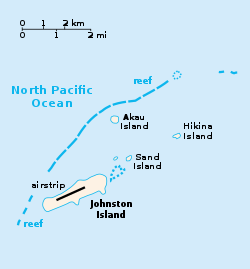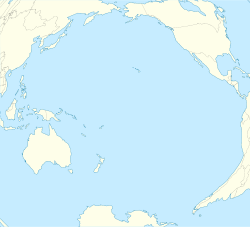History
In 1935 personnel from the United States Navy's Patrol Wing Two carried out some minor construction to develop the atoll for seaplane operations. They erected some buildings and a boat landing on Sand Island and blasted coral to clear a 3,600-foot (1,097 m) seaplane landing. [2] In November 1939 further work by civilian contractors commenced on Sand Island to allow the operation of one squadron of patrol planes with seaplane tender support. Part of the lagoon was dredged and the excavated material was used to make a plane parking area connected by a 2,000-foot (610 m) causeway to Sand Island. Three seaplane landings were cleared; one of them was 11,000 by 1,000 feet (3,353 by 305 m), and the other two were cross-landings, each 7,000 by 800 feet (2,134 by 244 m) and dredged to a depth of 8 feet (2.4 m). On Sand Island, barracks for 400 men, a mess hall, an underground hospital, a radio station, water tanks, and a 100-foot (30 m) steel control tower were built. [2] : 159
In February 1941, the United States designated Johnston Atoll a Naval Defensive Sea Area and Airspace Reservation.
In September 1941, construction of an airfield on Johnston Island commenced. A 4,000-by-500-foot (1,219 by 152 m) runway was built together with two 400-man barracks, two mess halls, a cold-storage building, an underground hospital, a fresh-water plant, shop buildings, and fuel storage facilities. The base was complete by the time of the Japanese attack on Pearl Harbor on 7 December 1941. [2] : 159
World War II
On 15 December 1941, the Imperial Japanese Navy submarine I-22 shelled Johnston Atoll from outside the reef, hitting several buildings but injuring no personnel. [2] : 159
In July 1942 the civilian contractors at the atoll were replaced by 500 Seebees from the 5th and 10th Naval Construction Battalions, who expanded the fuel storage and water production at the base and built additional facilities. The 5th Battalion departed in January 1943. [2] : 159 In December 1943 the 99th Naval Construction Battalion arrived at the atoll and proceeded to lengthen the runway to 6,000 feet (1,829 m) and add an additional 10 acres (4.0 ha) of parking to the seaplane base. [2] : 160
U.S. Navy and United States Marine Corps units based at Johnston Atoll during World War II included:
This page is based on this
Wikipedia article Text is available under the
CC BY-SA 4.0 license; additional terms may apply.
Images, videos and audio are available under their respective licenses.

